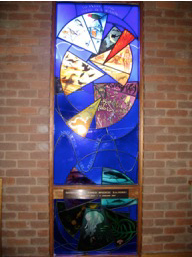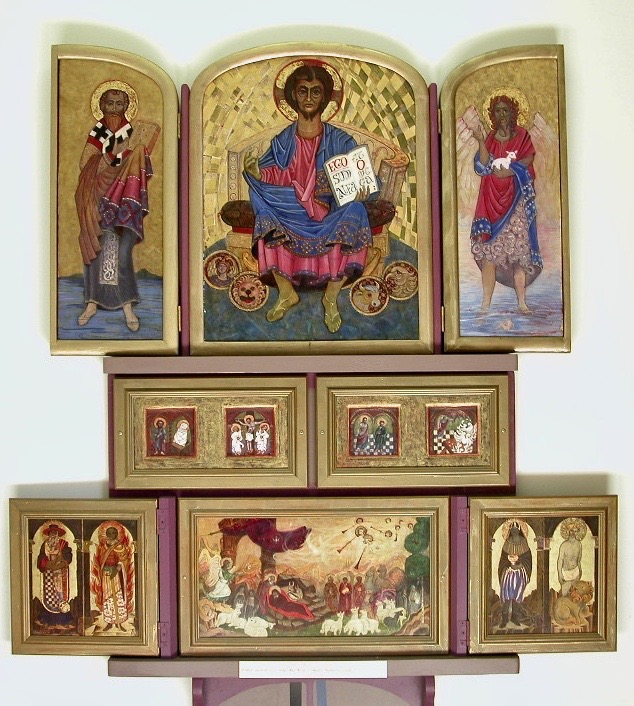Surfcoast Anglican Parish
Torquay, Anglesea, Aireys Inlet

St Aidan’s Windows and Icons

Memorial window to Barbara Mary Jenner McKenzie BA (Hons)
12 February 1937 – 4 January 1991
This window was constructed between 1993 and 1995 by R.J. (Bob) Albert of Linton, Victoria.
The window was designed by Bob Albert and commissioned by Barbara’s husband Graeme. The design evolved out of discussions between Bob and Graeme of Barbara’s life and interests – her character and personality, her likes and dislikes, her beliefs, her empathy with the Kings James translation of verses of Ecclesiastes 3, and her love for the birds, animals, plants and sea creatures around Aireys Inlet. Bob’s creation was an attempt to evoke the full density of meaning contained in the text, with something of the flair, exuberance and generosity characteristic of Barbara. As a work of art the window is of course autonomous, and as such is open to individual interpretation. However certain features are worth noting. The transparency of the sea birds is obtained by double glazing. The human figure has characteristics of both female and male, but no distinguishing features of race, hence it encompasses all humanity. The upper right portion is intersected by a wedge of flame, reminding us of the fragile nature of the area when devastated by bush fire. Further study of the window will be repaid by the discovery of almost hidden birds, plants, animals and sea dwellers. It is worth viewing both in sunlight and in diffused light. The window was dedicated on 27th August 1995.

In this window a white pillar of strength grows out from an environment of red – symbolising vitality, full-blooded life force and energy. Purple moulding inside a black bracket symbolises the mystical force in our existence. The black bracket moves the composition vertically and directs it with the obstacles of life (red horizontal bands) towards a shaft of pink glow, through which the spirit (white shape) returns upwards towards God. The border of the spiritual realm is marked by a horizontal band of green (a symbol of hope) and golden brown being earth (colours for warmth and protection).
Both windows interact through shape and colour relation to make them work together as a unity and to emphasise the family relation (grandmother/grandson).
The dedication in the window reads:
Winifred Barbara Meredith OBE BA MBBS 17 September 1895 28 July 1979

Like Jonathan Seagull, who loved flying and living, a birdlike ribbon is lifting off from the landing pad (black cross) up and away from the earthplane, moving towards new adventures, over playgrounds, jumping hurdles (blue horizontal bands) and puddles, now entering the shaft of light form where to launch into a new realm of life, drifting in a blue balloon that can take him where he desires.
In contrast to the ‘Barbara’ window, which is statuesque and restrained, the ‘Hamish’ window is full of life, exuberance, play, joy and surprise. There are lakes and beaches, buoys and sailing boats, ladders to climb and curtains to look behind, kites to fly and even a wheel that turns itself into a water slide. The white windbag/funnel drops low, to ensure that he can’t get lost, but is guided and carried up to where we all belong, with the Father. Twelve sparkling rondels remain behind to remind of twelve sparkling years of life.
The dedication in the window reads:
Hamish Lachlan Cameron McKenzie 17 September 1970 9 February 1983

The Triptych Altarpiece
The altarpiece consists of twelve panels arranged on three tiers:
1. The Nativity
2. Aspects of the life of Christ
3. A Christ Pantocrator
The bottom tier depicts, through symbols, the Nativity, flanked by four prophets. The figures of Mary, Joseph and the Christ child, with the ox and ass in front of the dark abyss of a cave is the main theme.
At the left, the good news blows across the world through the curtain that has hidden the past, whilst angels, blowing golden trumpets sound the glory at the upper right. Twelve sheep, symbolising the twelve apostles, follow the base line, whilst an image of the Magi is based upon a 15th Century icon of three Russian bishops. The two wings show the four prophets: (I to r) Isiah, Ezekiei. Jeremiah and Daniel.
The middle tier depicts four aspects of the life of Christ:
1. Christ the Healer - The Raising of Lazarus
2. Christ the Redeemer - The Crucifixion
3. Christ the Teacher- Doubting Thomas
4. Christ the Reformer - Cleansing the Temple
The upper tier portrays the Pantocrator as a Man of Sorrows; enthroned in glory on a golden throne and supported by the four evangelists; (I to r) Saint Matthew, Saint Mark. Saint Luke and Saint John. The tablet reads: "Alpha and Omega" - (I am the beginning and the end).
The left hand wing shows a figure of St Aidan, the Church's patron saint. Celtic signs and decorations are used that relate to his life and times. He holds the book of Kells and the mountain landscape in the background symbolises the island of Lindisfarne where he was once Bishop.
The right hand wing depicts Saint John the Baptist proclaiming the "Good News". His clothes and his dishevelled hair symbolise the time spent in the wilderness. The figure at his feet depicts a Roman river god, symbolising the classical past -"The Times of the Day" (one of the "Custodians of the Dead" or the "Dead Adam"), Thus through Adam. the message and the light of God continues to be revealed.
The painting technique of this altarpiece is called TEMPERA PAINTING. It is one of the oldest methods of decoration that reaches back to Egyptian, Greek and Roman times.
The images are painted on a firm wooden base, covered with smooth gesso (plaster). The pigment is mixed with egg yolk, pure water and vodka. The egg yolk, because of its fat content, acts as a binder for the pigment and the alcohol acts as a drier as well as a whetting agent. The mixture is applied in thin layers of fine cross-hatchings, beginning with a base colour of burnt umber (dark brown) and later, to the lighter colours of reds, blues and yellow ochres. There may be up to one hundred or more layers of pigment laid down until the desired colour is established. Gold leaf is used for embellishment and decorative effects.
This icon was written by Ray Woods and presented to the parish by Ray and Marion Woods in memory of their parents. It was dedicated by Archbishop Peter Watson in January 2003